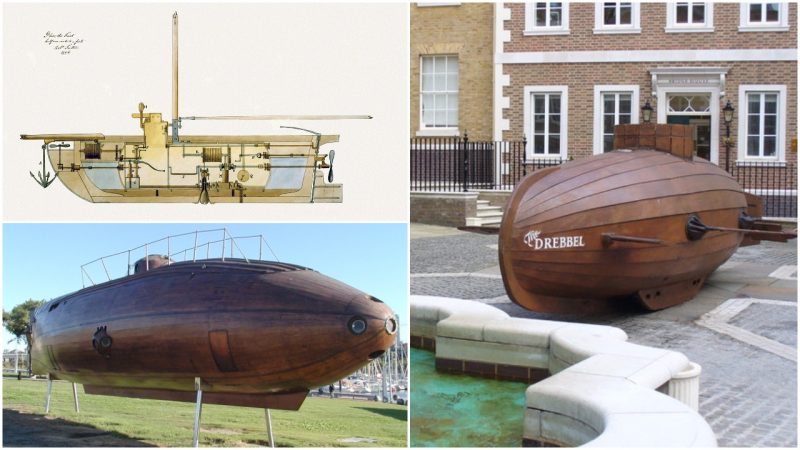The world’s first “underwater boats” (AKA, submarines) originated back in the 1500s. At first, these vessels were little more than glorified diving bells. They were powered by pedals and hand cranks. By the 19th century, inventors had created crude metal crafts that used engines and electricity. A few of these submarines were even used in combat. The following are nine of the early prototypes that would eventually transform into the subs we know today.
Drebbel: 1620-1624
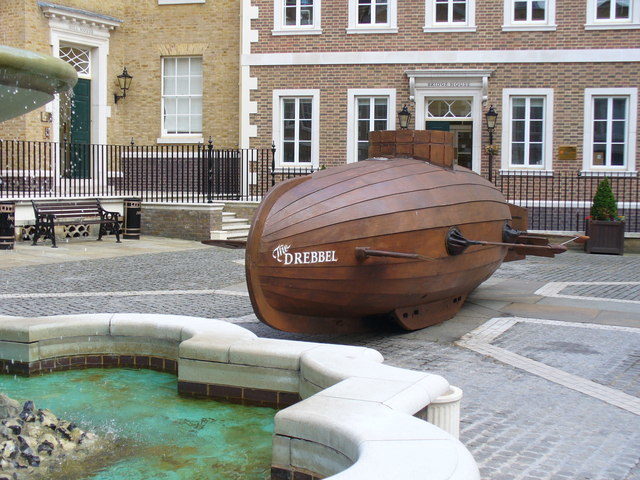
William Bourne, a British mathematician, created some of the earliest known plans for submarines. These designs were first drafted 1578, but the first working prototype wasn’t built until the 17th century. The builder was not Bourne, but a Dutch polymath and inventor named Cornelius Drebbel. At the time, he was in the employ of the British King James I. The first test drive occurred sometime around 1620. Drebbel, in the craft, dove fifteen feet beneath the River Thames in a demonstration before King James and thousands of Londoners. Sadly, none of Drebbel’s plans or engineering drawings survived to today; historians can only make guesses as to how Drebbel’s diving actually operated. The accounts we have today are divided. Some claim it submerged via a collection of bladders or wooden ballast tanks. Others suggest that a sloping bow and a system of weights were used to propel the boat underwater when it was rowed at full speed.
Turtle: 1775
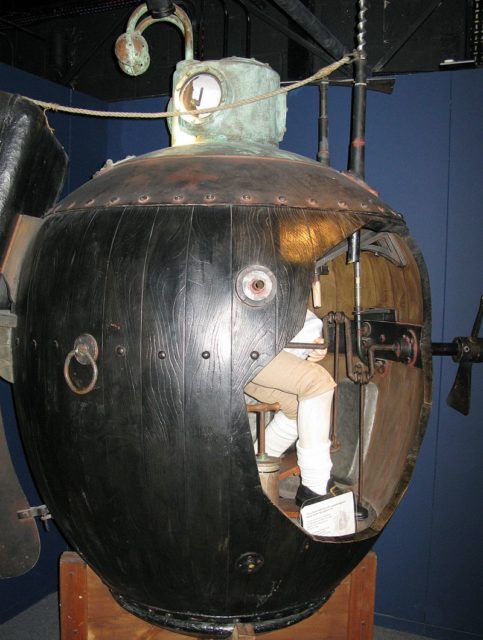
The second submarine emerged during the American Revolution. Inventor and Yale graduate David Bushnell created an experimental submarine that he named the Turtle. It was created as a secret weapon for the colonists to use. The Turtle was a wooden craft that could seat one person. Its propulsion was powered by a hand crank and a foot treadle. A water tank, which was operated by pedal, allowed the craft to submerge and surface. A lead ballast kept it upright whilst in the water. In theory, the Turtle could approach an enemy ship, undetected, and could screw a mine filled with 150 pounds of gunpowder onto the hull. In the wee morning hours on the 7th of September, 1776, Continental Army soldier, Ezra Lee climbed into the Turtle and set out on history’s first submarine attack. He piloted the British warship HMS Eagle that was in the New York Harbor. Unfortunately, Lee had received minimal training on the use of the craft and, after failing to attach a time bomb to the ship’s hull, he aborted the mission. The mine was detonated in open water. The inventor, Bushnell, eventually abandoned the submarine project after several failed missions. His fellow Patriots were still respected Bushnell, however. When asked about the Turtle, George Washington said, “I then thought, and still think, that it was an effort of genius…”
Nautilus:1800
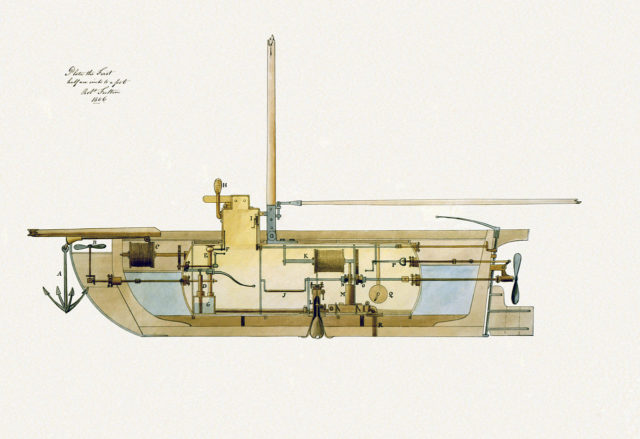
In 1800, Robert Fulton, an American inventor, was working for the French government when he designed the Nautilus—this submarine was an all-metal craft and is often called the first modern submarine. Measuring twenty-one feet in length, the Nautilus featured several revolutionary innovations, which include a cigar-shaped hull and a copper conning tower. As with its predecessors, the four-bladed propeller was hand-powered. It also had a collapsible mast and fan sail so that it could still travel on the surface. Driving planes assisted in submerging the craft. Fulton experimented with storing compressed air in copper bottles in order to provide oxygen for his crew. In the 19th century, the Nautilus had several successful test dives. It failed to win over both the French and English Navies, however. It was dismantled and sold for scrap metal. After the failure, Fulton returned to America and found success when he developed the world’s first commercial viable steamboat.
Sea Devil:1855
The fourth submarine is called the Sea Devil. It was the result of many years of experiments and failures. Wilhelm Bauer’s first submarine was built in 1850, but it sank in fifty feet of water during a demonstration—Bauer barely escaped with his life. Determined, the Bavarian inventor continued tweaking his design. He received funding from the Russian government for a new vessel. While in St. Petersburg in 1855, he constructed the Sea Devil. It was fifty-two feet long and was capable of carrying a crew of a dozen men. It boasted multiple ballast tanks for added buoyancy, a crude airlock, and a propeller that was powered by crewmen operating an internal treadmill—all of these facets were technological breakthroughs for the time. The Sea Devil made more than 130 successful dives before being lost at sea. One of the most unusual dives it made was during the coronation of Czar Alexander II. The Sea Devil was submerged with a four-member brass band aboard. According to witnesses, a rendition of the Russian national anthem could be heard coming from beneath the waves.
H.L. Hunley:1863
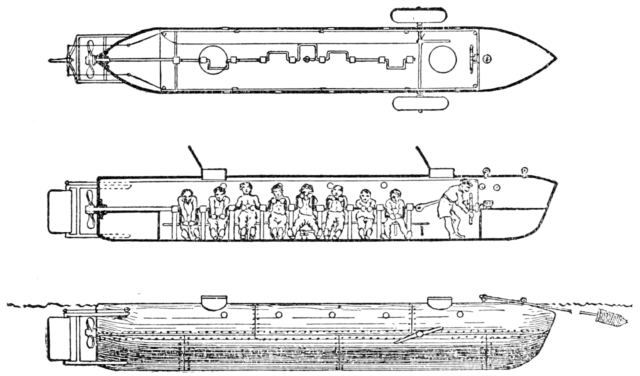
In 1863, H.L. Hunley, a primitive attack submarine, was designed to help the Confederacy escape the stranglehold of the Union naval blockades during the Civil War. It was built privately in Mobile, Alabama. Fashioned from a recycled iron steam boiler, it had enough space for eight crewmen—one person would steer and the other seven would turn the hand cranks that powered its propeller. On its bow was a seventeen-foot spar mounted with a torpedo. This would detonate when it was rammed against an enemy ship. The Hunley earned the nickname “peripatetic coffin” during the early tests and for good reason. On two of its trial runs, it sank and killed a total of thirteen crewmen, including its namesake Horace Lawson Hunley, who was a marine engineer. Despite the failures, the sub was repeated salvaged. On February 17, 1864, Lieutenant George Dixon and a crew of volunteers sailed the Hunley into the Charleston Harbor. They successfully drove its torpedo into the side of the sloop-of-war USS Housatonic. The Union ship sank within minutes, but so did the Hunley, probably because of the damage sustained during the attack. Sadly, the first submariners in history to destroy an enemy ship, Dixon and his Confederates, all perished.
The Plongeur (The Diver): 1872
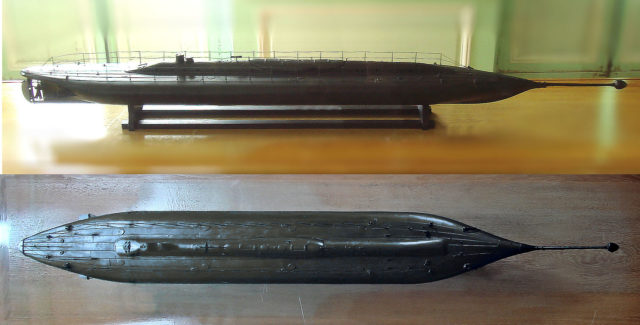
The next submarine was one of the first to use mechanical power. The Plongeur (The Diver) was designed by French naval officers Simeon Bourgeois and Charles Brun. Instead of relying of hand cranks, foot pedals, or treadmills as a means of propulsion, this giant sub used a piston engine powered by compressed air stored in tank. This air also helped provide the crew with oxygen and served as a means for automatically emptying its ballast tanks. Measuring at 140 feet in length, The Diver made several successful dives. Its limited air supply and dangerously unstable structural design led to its removal from active duty in 1872. Later, in 1888, many of these problems were corrected in the new French submarine Gymnote, which was a more seaworthy craft that ran on electric power.
Ictineo II: 1865
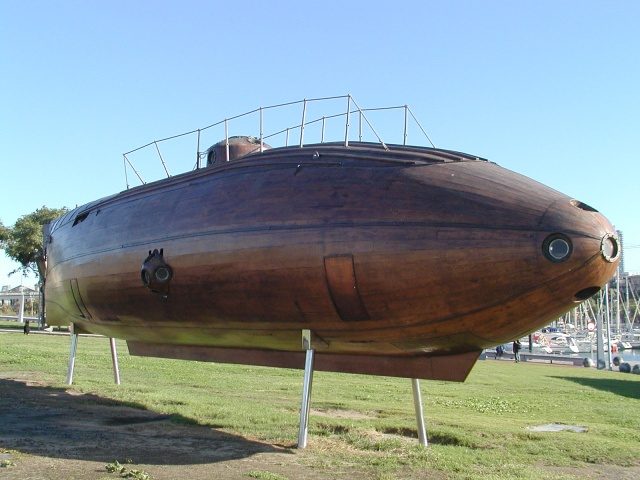
The seventh early submarine on this list was built by Spanish political activist and inventor Narcís Monturiol i Estarriol. His motivation to design a submarine stemmed from his witnessing the drowning death of a coral diving in 1857. Worker safety at the time was not a priority, and Monturiol wanted to change that. Thus, the Ictineo II was developed. Often called the world’s first engine-powered submarine, the Ictineo II was a successor of an earlier diving boat called, unsurprisingly, Ictineo I. Ictineo II, measuring forty-six feet in length, achieved remarkable stability due to a system of weights and four pump-operated ballast tanks positioned inside its double-hull. Monturiol developed an anaerobic steam engine that used a chemical reaction to create both heat and oxygen—this is what turned its propeller. His design seemed to have worked. The Spanish inventor made a successful dive late in 1867. Unfortunately, the submarine was taken apart and sold for scrap metal due to funding shortages. Its revolutionary propulsion system would not be seen again until the 20th century.
Argonaut: 1897
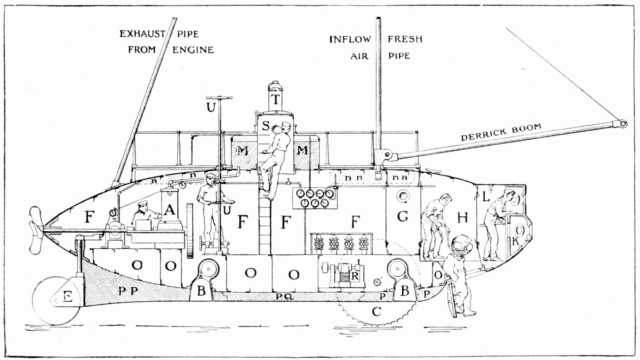
The late 19th century saw massive improvements in submarine technology; most undersea boats, however, were still only capable of performing short runs near the shore. This would change in 1897. An American engineer named Simon Lake designed and built the Argonaut, a thirty-six-foot submarine that was powered by a 30-horsepower gasoline engine. The most unusual feature on the Argonaut was a set of wheels that allowed it to drive on the seafloor. Other features that the sub had was a periscope, a diving chamber, and a floating hose that provided air for the engine and the crew. Initially, Lake used the Argonaut to salvage sunken shipwrecks in Chesapeake Bay—In 1898, however, he sailed it from Norfolk, Virginia to Sandy Hook, New Jersey. This trip has since been called the first open ocean voyage by a submarine and it earned Lake widespread acclaim. Jules Vern, author of the book 20,000 Leagues Under the Sea, even sent him a congratulatory letter. Lake would go on to develop dozens of underwater vehicles for the U.S. Navy and produce more than 200 patents.
USS Holland: 1898
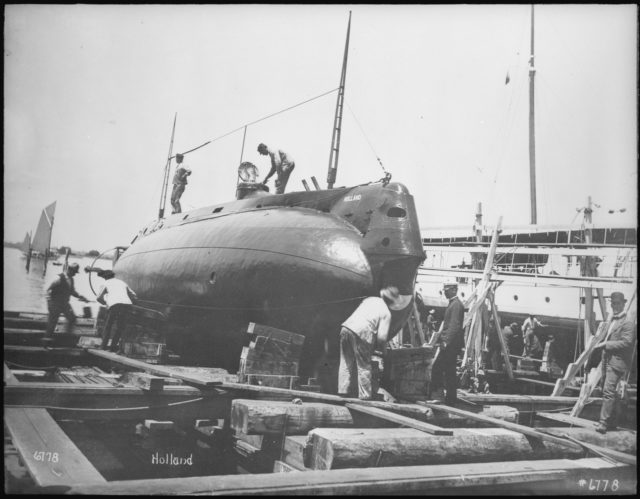
The first submarine to be officially commissioned by the U.S. Navy was the USS Holland on October 12, 1900. Built two years prior in 1898, the sub took its name from its inventor, John Philip Holland. Holland was an Irish-born engineer who was one of the most innovative pioneers in submarine technology of the late-19th and early 20th centuries. Fifty-four feet in length, the USS Holland had a single torpedo tube and a pneumatic cannon that was known as a dynamite gun. A four-cylinder gasoline engine powered the craft at a surface travel. For underwater travel, it had a 160-horsepower electric motor. Holland himself never saw combat, but his submarine served as a training vessel, as well as an experimental craft for the United States’ first crop of submariners. By the time the USS Holland was decommissioned in 1905, half a dozen other attack subs were in service for the Navy.
